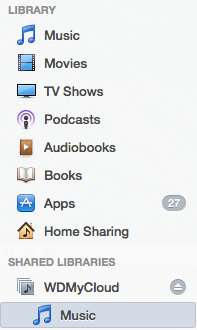Working with cloud services like Dropbox or Google Drive is easy, fast and efficient, but for a while now there have been concerns about levels of data privacy & security. As a solution, Western Digital launched My Cloud, a Network Attached Storage (NAS) device that lets you have your own personal cloud.
The concept is simple, with a personal cloud you gain full control over your digital content and instead of paid subscriptions, it involves a one off, very reasonably priced purchase of £129.99 for the entry level 2TB model (also available in 3TB & 4TB).
This isn’t a revolutionary concept by any means, but My Cloud is Western Digital’s attempt to make personal cloud storage a more accessible thing to the average Joe.
A Familiar Look
For anybody already familiar with WD’s My Book Live range of network hard drives, My Cloud is essentially a refreshed, updated and rebranded version.
On the outside, the device maintains the brand’s usual design style with the single noticeable change being a white glossy plastic body rather than their usual black. Around the back of the drive, there’s an ethernet port for wired connectivity to your router and a newly introduced USB 3.0 port – usable for direct photo uploads or as an expansion port to bump up My Cloud’s storage capacity.
Setting Up Your Cloud
Getting started is very much a plug & play affair. Simply connect the power supply, plug in the ethernet cable to the router and that’s it – My Cloud is automatically recognised by your WiFi network (and devices) so there won’t be any complex configuration involved.
Once it’s all set up, My Cloud will appear with three default folders: Public, SmartWare and TimeMachineBackup (for Mac backups). You can of course add & remove folders as you please, but I like that they’ve created defaults for an easy start.
Personalised Configurations
Once you log in to your WD My Cloud dashboard (you’ll have a shortcut on your desktop), you’ll have the option to set individual user permissions, set up remote access and even control access to specific folders – all via your web browser. They’ve made it really simple to use & navigate and although it isn’t the most exciting interface, it’s a preferable trade off for ease of use.
If by chance you need support at any point WD includes ‘Learning Centre’, a useful source of information on how to use & set up your My Cloud.
Apps & Remote Access
When I downloaded the apps for iOS and Android, I was pleased to see that I could add my Google Drive, Dropbox, SkyDrive and even older WD NAS devices for quick access to my files through one app. It’s a shame that you’re restricted to viewing rather than editing files though, making it better suited to media consumption rather than file editing.
If you’re constantly sharing files you’ll be happy to know that the sharing functionality on iOS and Android is pretty good. As I expected Android has more options to choose from. I was able to share a file using social media, add the file to Dropbox and send it via Skype (amongst other choices). iOS has plenty of options too like emailing links to files and opening in Dropbox, but the lack of a social sharing option was disappointing.
Since it’s a personal cloud, My Cloud doesn’t actually store anything on Western Digital’s servers. Data is kept entirely on your device and you’ll be using their services for connection purposes only. Also, WD adds an extra layer of security with an optional passcode lock for the app. It’s a very logical feature to have, especially if you’ll be adding your other cloud accounts, so that really stood out and impressed me.
In terms of performance, streaming photos and music files was smooth and watching a 2GB HD movie at the limits of my WiFi network was fast and seamless using my iPhone 5 & iPad 3. Using my Nexus 7 tablet (1st gen) wasn’t as fast, but it wasn’t intolerable either.
Surprisingly enough, the remote access functionality is an aspect of the My Cloud that I was disappointed with. Without the dedicated desktop app (downloadable from the Learning Centre), you’re reliant on Java to access your files via a browser, and in my testing I came across several compatibility issues on my computers, Windows or Mac. It wasn’t a fluid experience at all, so if you come across the Java issue too, your best bet will be to use your smartphone or tablet and email yourself the files instead.
Backing Up
Usually you’d be reliant on plugging in an external hard drive to back up your data, but with the My Cloud it can be done wirelessly whether you’re running Windows or Mac. It actually stores TimeMachine backups for Mac in a separate folder by default which is convenient – although you can customise the destination folder for your backups manually.
Combined with the customisable user permissions, you’ll even be able to manually restrict access to certain folders, a useful feature for keeping backups private.
As with any hard drive though, you should always have a contingency plan and luckily, that’s where the USB 3.0 port comes in. Using WD’s feature called ‘Safepoints’, you can use that USB port to connect another hard drive dedicated to backing up your My Cloud data. Yeah I know it’s a lot of backups to think about – but in a nutshell the Safepoints feature will restore your entire My Cloud’s data should you ever need to.
Performance

The performance of My Cloud will be heavily reliant on your own home WiFi’s quality, how many devices are connected, distance from the router and a bunch of other environmental factors.
From my personal experience though, I felt like the data transfer speeds were quite slow regardless of where I was in the house. Using a Virgin Media dual band router under the 5G bandwidth, I found that moving a folder with 10 songs (85MB size) took just under 1 minute 27 seconds, and a 1.9GB video took between 30-40 minutes.
It’s worth noting that I transferred these files from the 2nd floor of my house to My Cloud which is located on the ground floor – so it was subject to a lot of interference. Either way, uploading large files to the drive will either involve physically transferring them using the USB port, or a lot of patience.
On a more positive note, streaming media to smartphones, tablets or computers around the house was fast & effortless. There was only a little buffering involved and even when I skipped to half way through a video – it took hardly any time to start playing again. Even from my workplace, I was able to play the exact same movie with no streaming issues whatsoever which was impressive.
Streaming songs on iTunes was just as easy, since My Cloud appears conveniently under your Shared Libraries in iTunes ready to play your music library.
The Bottom Line
As a personal cloud for constantly editing documents, WD’s My Cloud doesn’t feel like it competes with the likes of Google Drive for efficiency and performance. The fluid desktop integration and real time sync of Google Drive makes it a daily part of my workflow that I just can’t see being replaced by My Cloud right now.
The wireless transfer speeds for larger files weren’t the fastest which made uploading content a lengthy task, although the obvious solution would be to use the USB 3.0 port instead to physically mass-transfer your content to My Cloud.
Looking beyond those niggles, where My Cloud excels is its ability to serve up media on the go. Whether it’s video content, photos or music, this is going to be a personal cloud (and media hub) that’ll be cost-effective, easy to use and most importantly, secure. Paired with a well made mobile app – accessing, uploading, downloading and sharing content is going to be super easy even for the novice users in the family.
ORDER FROM AMAZON U.K. ORDER FROM AMAZON U.S.


